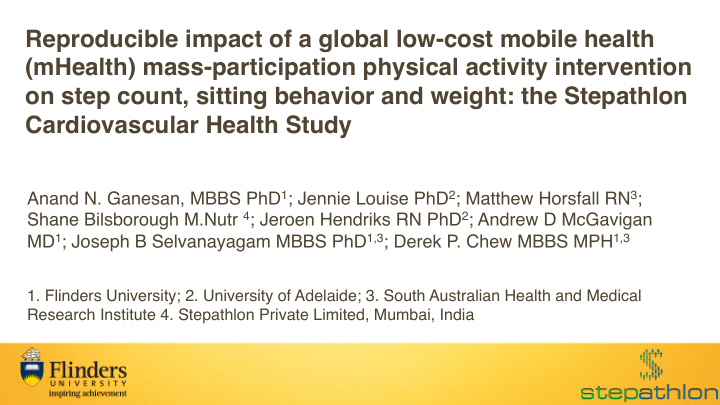



Reproducible impact of a global low-cost mobile health (mHealth) mass-participation physical activity intervention on step count, sitting behavior and weight: the Stepathlon Cardiovascular Health Study Anand N. Ganesan, MBBS PhD 1 ; Jennie Louise PhD 2 ; Matthew Horsfall RN 3 ; Shane Bilsborough M.Nutr 4 ; Jeroen Hendriks RN PhD 2 ; Andrew D McGavigan MD 1 ; Joseph B Selvanayagam MBBS PhD 1,3 ; Derek P. Chew MBBS MPH 1,3 1. Flinders University; 2. University of Adelaide; 3. South Australian Health and Medical Research Institute 4. Stepathlon Private Limited, Mumbai, India
Introduction § Physical inactivity, sedentary behavior and obesity are well-recognized drivers of global cardiovascular morbidity and mortality § The global inactivity epidemic is occurring simultaneous with a global revolution in mobile device technology § Proof-of-concept for mHealth and workplace-based pedometer lifestyle interventions has been demonstrated in randomized trials in high-income countries § Translation into globally distributed in a “real-world” mass-participation mHealth implementation has not been shown
The Stepathlon Event Budd-E, 3-D accelerometer § 100-day international worksite-based based pedometer pedometer program conducted using mHealth technology § Participants organized in worksite-based teams of 5, issued inexpensive pedometers § Program conducted via an interactive platform available on mobile devices and world-wide web § Encouraged to increase daily steps and physical activity as part of a team-based race around virtual world § Participant cost was modest ($US 50 for India, $US 60 outside India) World-wide-web Mobile-device user interface user interface
Baseline Characteristics of Study Participants § N=69,219 participants across the years 2012-2014, 64 countries, 1401 cities 1 8 -2 9 3 0 -3 9 1 6 ,4 3 0 M ale 4 0 -4 9 (2 3 .8 % ) 5 0 -5 9 F e m a le 6 0 -6 9 5 2 ,4 7 3 (7 6 .1 % ) G e n d e r A ge E a s t A s ia a n d P a c ific H ig h In c o m e n o n -O E C D E u ro p e a n d C e n tra l A s ia U p p e r M id d le In c o m e L a tin A m e ric a a n d C a rrib e a n L o w e r M id d le In c o m e M id d le E a s t a n d N o rth A fric a L o w In co m e S u b -S a h a ra n A fric a H ig h In c o m e O E C D N o rth A m e ric a S o u th A sia R e g io n a l In c o m e D istrib u tio n G ro u p in g
Overall Impact of Stepathlon on Step Count and Exercise Days Ganesan, JACC, 2016 (in press)
Stepathlon associated with improved outcomes in subgroup analyses Ganesan, JACC, 2016 (in press)
Conclusions § Stepathlon demonstrates the efficacy and feasibility of a self- sustaining low-cost, global, mass-participation workplace lifestyle program delivered electronically to a distributed participant base via mHealth technology § Reproducible statistically significant improvements in physical activity and weight seen in distributed geographic and sociocultural/ economic settings § Demonstrates capacity of endogenous innovation in lower-middle income countries to develop low-cost internationally applicable mHealth programs
Recommend
More recommend